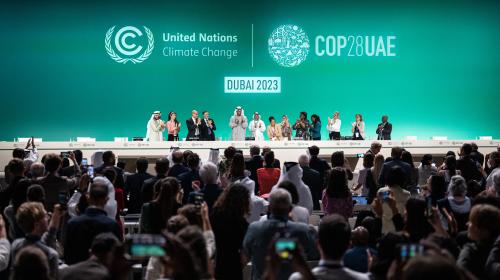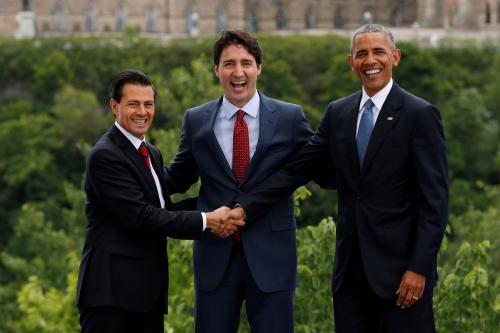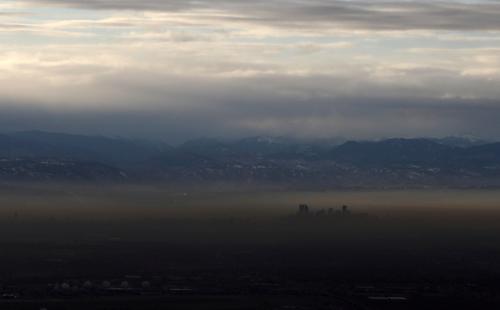The United States has been on the move in recent years to address methane emissions—an intensive, short-lived climate pollutant responsible for about 30% of current global warming. This has been most evident in the oil and gas sector, which contributes about 30% of American and 25% of international methane releases. The U.S. leads the world in the annual production of oil and gas, as well as related methane emissions. How might each of the presidential nominees confront methane issues related to the energy sector? This blog examines prospects under either a Harris administration or a second Trump term.
Many factors have converged in shifting methane from the periphery of climate policy deliberations onto center stage, including its technological implications. Major advances in methane measurement, including satellites and remote sensing, are increasingly supplanting traditional estimation methods. They offer far superior precision than existing techniques, and routinely detect greater emissions than previously disclosed. Numerous technologies to minimize releases are readily available, and many are highly cost-effective when calculating benefits from methane gas capture and use as an energy source. Scholarly analysis and media coverage of methane have proliferated, drawing unprecedented attention to a once-obscure topic.
The topic of methane emissions is not new
Methane is not a new natural resource or environmental concern. A few leading production nations, most notably Norway, many decades ago established effective and durable policies, which have largely eliminated methane loss at or near the point of production. In the U.S., methane governance has long been dominated by production states, many of which have historically maintained very accommodating terms for those firms with poor track records and reluctance toward embracing technologies to tighten measurement or reduce emissions. In Texas, legislative options to capture methane wasted through flaring were first introduced in the 1890s but the state has long struggled to develop an effective mitigation strategy. Obama-era efforts to begin expanding federal oversight faced aggressive responses from the succeeding Trump administration, which largely preserved decentralized governance through the 2010s.
To date, the Biden-Harris administration has pursued an aggressive, multi-faceted approach to methane, both nationally and globally, although this remains a work in progress. Domestically, this has built, in part, on best practices by a number of major production firms and the practices of several exceptional states, particularly Colorado and New Mexico. Following a combination of legislative and executive actions, the federal government is now attempting to stand up a multi-part approach to methane minimization in the oil and gas sectors by simultaneously deploying new pricing, regulatory, and subsidy policy tools.
The Environmental Protection Agency (EPA) is attempting to implement a legislated fee on methane emissions exceeding a performance standard and linked to a revamped measurement system. This represents the first American price placed on a greenhouse gas. A series of new regulatory provisions are being finalized by the EPA, including expanded leak detection and repair and more consistent use of the latest mitigation technology, covering far more facilities than ever before. Fees can be waived if all production states comply with new regulations through their formal implementation plans. Accredited third-party auditors will be allowed to monitor sites and share findings with EPA for possible enforcement actions. In turn, billions of federal dollars are being invested to assist industry and states with transition costs and remediating long-neglected orphan wells that can seep methane long after active operation. A parallel Bureau of Land Management methane regime is also emerging for oil and gas produced on federal lands, including first-ever royalty payments on methane waste. In turn, new rules to reduce methane loss from pipelines are being developed by the Pipeline and Hazardous Materials Safety Administration.
These efforts represent a sea change in American methane policy, although little of it will be finalized or operational before the end of the Biden-Harris administration. Implementation will require completion of a very complex suite of policies amid mounting pushback. Nonetheless, if these new provisions are sustained politically, endure legally, and are implemented effectively over time by federal and state agencies, the U.S. could reasonably vault into a global leadership role.
What could the Harris administration do on methane policy?
Kamala Harris has not publicly discussed methane policy since becoming the Democratic presidential nominee. Her most prominent public comments related to energy policy have attempted to explain her pivot away from earlier vows to ban fracking. But it seems quite likely that any administration she steers would continue to pursue the implementation of new policies initiated during her vice presidency. This would entail a massive and sustained administrative lift, requiring considerable expansion of federal and state capacity to measure, monitor, and mitigate emissions while enforcing violations. Mounting political and legal opposition are rapidly emerging from many production state attorneys general, regulatory energy agencies, associations representing oil and gas producers, and members of Congress.
These steps generate a series of challenging questions that include: Should all states have to fully meet regulatory standards before any are exempt from paying fees? Is the newly proposed measurement system fair to industry or might it result in overcounting emissions after decades of chronic underestimation? Are the EPA’s plans to engage third-party auditors beyond statutory scope? Should states be required to measure methane losses to receive federal grants to plug orphan wells? Should the federal government delay implementation timetables until disagreements can be resolved or give states additional years to formulate compliance plans? Should energy firms that produce relatively small amounts of oil and gas, but have high emission rates, retain historic exemption from regulation? And so on.
Protracted intergovernmental battles over these and other issues linked to a likely Harris administration methane policy agenda could require many years to resolve. In August 2024, a large coalition of production states and industry sought a Supreme Court stay to freeze EPA methane regulatory development under the Clean Air Act. This contends that the EPA is establishing an “authoritarian national command” violating the cooperative federalism provisions of air quality legislation. Sorting out these disputes and moving some version of these proposed policies into implementation would likely dominate any Harris administration domestic efforts on oil and gas sector methane.
What could a Trump administration do on methane policy?
In contrast, it is somewhat less clear to discern what course a second Trump administration might pursue on methane. Despite his lengthy campaign to regain office, Trump has said nothing publicly about methane. Instead, he has reserved most remarks relevant to climate policy on other issues, including his oft-discussed reservations about electric vehicles, wind turbines, and solar farms. Trump has also vowed repeatedly to pursue all-out oil and gas production and major export expansion, while cultivating heads of production firms for substantial campaign support. At the same time, Trump has disavowed the Project 2025 blueprint to reinvent the American administrative state and has not specified any plans for addressing methane from oil and gas or other sectors.
Nonetheless, it seems safe to assume that his far-reaching first-term efforts to reverse fledgling Obama-era policy would be a model for his sequel, even in cases where recent legislation (including the 2021 Congressional Review Act and the 2022 Inflation Reduction Act) calls for new federal steps to address methane. In a 2020 Brookings book examining the Trump administration’s use of executive power, Frank Thompson, Kenneth Wong, and I characterized its approach to methane as a strategy of “regulatory withdrawal, replacement, repeal, and suspension” of Obama initiatives. As a result, most governmental authority over methane emissions remained in state hands.
These precedents lead to the question of how production firms and states would respond to any second iteration of a Trump administration that could attempt to undo federal policies launched by his immediate predecessor. In the absence of federal oversight, would efforts to more rigorously measure and reduce methane releases diffuse more rapidly and uniformly across the U.S. than they have to date? Thus far, widespread variation in state and industry performance endures and has weakened American claims to international methane leadership.
National performance variation and the modest nature of global authority
There is no singular global authority on methane measurement or policy, but the International Energy Agency (IEA) stands out as an increasingly credible source on global and national emissions measurement. Its 2024 annual report continues a recent pattern of utilizing advanced methods to measure national methane emissions intensity. Consistent with recent years, the findings point to the U.S.’s performance as being well ahead of laggards, such as Russia, Iran, Venezuela, and Turkmenistan. But the nation is still well behind leaders, such as Norway, Saudi Arabia, and Canada. It lands in the middle of the pack among the largest national energy producers, with emissions intensity scores quite close to those of China. In North America, Canada has pursued sustained development and implementation of advanced methane regulations during the past decade, while both America and Mexico have wobbled, which may contribute to its superior performance in recent IEA studies. Legislators from both Europe and the U.S. have called upon IEA to establish international standards for measuring energy sector methane emissions.
Recent reports from the Energy Information Administration indicate declining American venting and flaring rates in recent years, albeit reliant on traditional reporting methods that have historically underestimated emissions and provided limited data on leaks. An ever-growing body of technically advanced scholarly studies find substantial regional variation in methane loss rates. America’s vast physical scale and distribution of production basins leads to lengthy and complicated supply chains which include a diverse tapestry of jurisdictions and private firms. Much production focuses on oil, often leaving associated gas capture a secondary concern unless faced with direct regulatory requirements.
This uneven record undermines U.S. credibility and potential leverage in a sector where its role in production and emissions remains so large globally. A stronger, more consistent domestic record could boost the Global Methane Pledge initiative launched jointly in 2021 by the U.S. and the European Union. This invites national vows to support a 30% reduction in 2020 global methane releases by 2030. The Pledge has secured commitments from 157 nations, although major methane producing nations such as China, India, and Russia have not joined. It could also evolve into an international framework that relies on sophisticated measurement to assess national progress, compels more robust and consistent mitigation policy, and accelerates access to advanced technology globally. Such actions might emulate some of the provisions that have made the 2016 Kigali Amendments to the Montreal Protocol for transforming cooling sector chemicals the global climate policy gold standard. Kigali links technological advancement with sustained implementation of a suite of interwoven regulatory, trade, and funding provisions. Bipartisan legislative steps to support this transition were taken under both Donald Trump and Joe Biden, and it seems plausible that progress would continue under either a President Trump or Harris.
Linkages to cross-border trade
One option for governing methane emissions beyond American borders could link cross-border energy trade with consequences for substandard methane performance. Europe already leads the way in the climate-trade arena, linking its internal carbon pricing system with trade through carbon border adjustments set to begin in 2026. It has also initiated a comparable process to address oil and gas sector methane lost in producing nations before export. Europe intends to combine tougher methane standards on continentally produced energy with comparable requirements for imported energy. This includes possible financial penalties or fees for low performance. Congresswoman Julia Brownley (D-CA) recently introduced the first American “methane border adjustment mechanism” bill for imported energy, leveraging the new U.S. methane fee. This approach remains in very early and uncertain developmental stages but offers a glimpse into what future methane governance might entail if it moves beyond the existing system of non-binding emission reduction pledges.
The Global Methane Pledge, like the Paris Agreement, is not a Senate-backed treaty but merely a presidential executive agreement. Lacking legislative endorsement, it is highly vulnerable to rapid reversal by whomever occupies the Oval Office at a given moment. A second Trump presidency could unilaterally end American engagement in the Pledge, either through formal steps or by simply ignoring it, without offering any replacement. Any Trump efforts to undo the international methane work of his predecessor could also undermine domestic capacity to encourage other producing nations to improve their performance, unless his administration was to unveil some alternative strategy which to date has been kept under wraps.
On the contrary, a Harris administration would likely work to bolster the Pledge and continue recent American initiatives to expand domestic and global efforts to reduce all sources of human-caused methane and other “super pollutants.” However, it would face two major challenges. One, can it stand up its suite of complex domestic policies in a timely, coordinated, and effective fashion and ultimately demonstrate consistent American performance excellence within its boundaries? Two, can it find credible ways to leverage any domestic methane progress with the many nations that continue to lag on methane mitigation?
A newly-issued report from the Global Carbon Project, an international research entity that monitors climate emissions, concludes that methane emissions from multiple sectors have risen far more rapidly than carbon dioxide in recent decades. The sheer volume of methane emissions and their front-loaded climate warming impacts make them increasingly significant focal points for domestic and international climate policy. These findings should present significant challenges and opportunities for whomever next occupies the presidency.






Commentary
The future of American methane policy
September 19, 2024